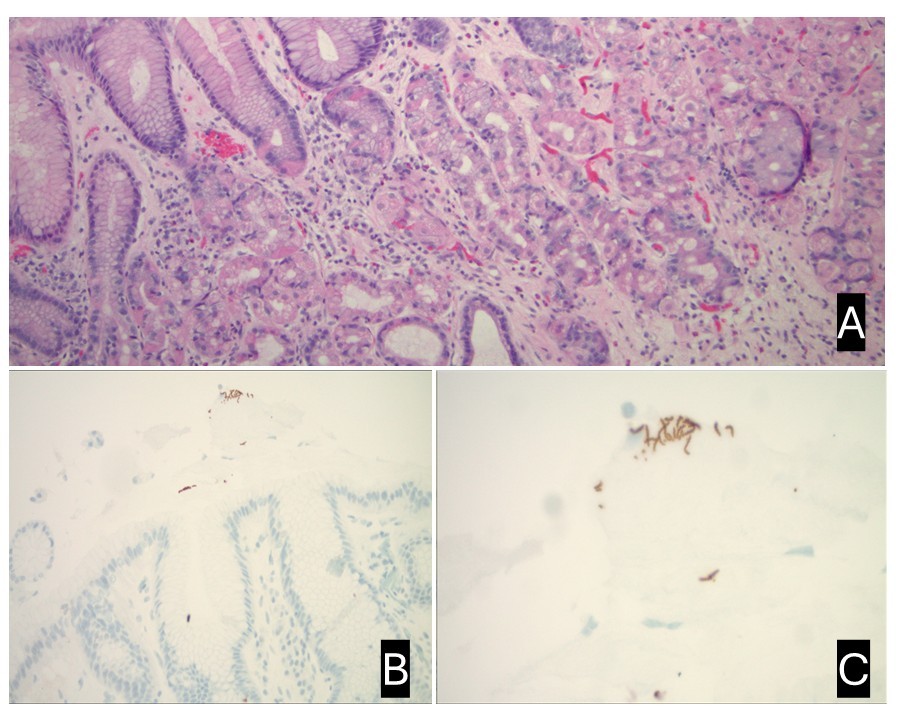Tuesday Poster Session
Category: Infections and Microbiome
Beyond H. pylori: A Case of Helicobacter heilmannii Gastritis
P5620 - Beyond H. pylori: A Case of Helicobacter heilmannii Gastritis
Tuesday, October 28, 2025
10:30 AM - 4:00 PM PDT
Location: Exhibit Hall
- MA
Monica Arora, DO (she/her/hers)
Mather Hospital, Northwell Health
Port Jefferson, NY
Presenting Author(s)
Monica Arora, DO1, Eugene Licht, MD2, Swati Gupta, DO1
1Mather Hospital, Northwell Health, Port Jefferson, NY; 2Northwell Health, Setauket, NY
Introduction: Helicobacter pylori (H. pylori) is a leading cause of peptic ulcer disease (PUD), gastric adenocarcinoma, and gastric mucosa-associated lymphoid tissue (MALT) lymphoma. Helicobacter heilmannii sensu lato (H. heilmannii) is a group of Helicobacter species that are much less prevalent in humans but are associated with similar pathology. We present a case of a 78-year-old man with H. heilmannii infection that was eradicated with quadruple therapy.
Case Description/
Methods: A 78-year-old male presented with dysphagia. Endoscopy revealed an irregular z-line, hiatal hernia, moderate inflammation of the gastric antrum/body, and mild inflammation of the duodenal bulb. Esophageal biopsies noted mild reflux esophagitis. Duodenal biopsies revealed mildly increased intraepithelial lymphocytes. Gastric biopsies noted chronic active gastritis without intestinal metaplasia. Hematoxylin and eosin staining together with immunohistochemical (IHC) staining revealed elongated, tightly-spiraled bacilli consistent with H. heilmannii (Figure A, B, C).
The patient received 14 days of quadruple therapy (proton pump inhibitor, bismuth subsalicylate, tetracycline, and metronidazole). Endoscopy performed 6 weeks after therapy confirmed eradication of H. heilmannii. Gastric intestinal metaplasia and Barrett’s esophagus were noted. Surveillance is planned.
Discussion: H. heilmannii infection is rare, with prevalence below 1% in Western populations, but it is more frequent in rural settings and among those with close contact with cats, dogs, pigs, or cattle—highlighting its zoonotic potential.
Unlike H. pylori, which can be diagnosed with non-invasive testing, H. heilmannii diagnosis typically relies on histological detection using silver-based staining or IHC. However, overlap with other Helicobacter species on IHC complicates differentiation. Polymerase chain reaction with gene sequencing is the gold standard for definitive identification, but its use is limited by cost and availability.
Although standard H. pylori therapy regimens are reportedly effective against H. heilmannii, no specific treatment guidelines exist. Despite its rarity, the infection can cause significant morbidity and mortality given its association with dyspepsia, PUD, gastric adenocarcinoma, and gastric MALT lymphoma. Awareness of H. heilmannii’s unique epidemiology and clinical significance will ensure prompt diagnosis and treatment, improving patient outcomes.

Figure: Figure A: Hematoxylin and Eosin; Chronic active gastritis.
Figure B and C: Immunohistochemistry: Elongated tightly-spiraled bacilli, characteristic of H. heilmannii.
Disclosures:
Monica Arora indicated no relevant financial relationships.
Eugene Licht indicated no relevant financial relationships.
Swati Gupta indicated no relevant financial relationships.
Monica Arora, DO1, Eugene Licht, MD2, Swati Gupta, DO1. P5620 - Beyond H. pylori: A Case of Helicobacter heilmannii Gastritis, ACG 2025 Annual Scientific Meeting Abstracts. Phoenix, AZ: American College of Gastroenterology.
1Mather Hospital, Northwell Health, Port Jefferson, NY; 2Northwell Health, Setauket, NY
Introduction: Helicobacter pylori (H. pylori) is a leading cause of peptic ulcer disease (PUD), gastric adenocarcinoma, and gastric mucosa-associated lymphoid tissue (MALT) lymphoma. Helicobacter heilmannii sensu lato (H. heilmannii) is a group of Helicobacter species that are much less prevalent in humans but are associated with similar pathology. We present a case of a 78-year-old man with H. heilmannii infection that was eradicated with quadruple therapy.
Case Description/
Methods: A 78-year-old male presented with dysphagia. Endoscopy revealed an irregular z-line, hiatal hernia, moderate inflammation of the gastric antrum/body, and mild inflammation of the duodenal bulb. Esophageal biopsies noted mild reflux esophagitis. Duodenal biopsies revealed mildly increased intraepithelial lymphocytes. Gastric biopsies noted chronic active gastritis without intestinal metaplasia. Hematoxylin and eosin staining together with immunohistochemical (IHC) staining revealed elongated, tightly-spiraled bacilli consistent with H. heilmannii (Figure A, B, C).
The patient received 14 days of quadruple therapy (proton pump inhibitor, bismuth subsalicylate, tetracycline, and metronidazole). Endoscopy performed 6 weeks after therapy confirmed eradication of H. heilmannii. Gastric intestinal metaplasia and Barrett’s esophagus were noted. Surveillance is planned.
Discussion: H. heilmannii infection is rare, with prevalence below 1% in Western populations, but it is more frequent in rural settings and among those with close contact with cats, dogs, pigs, or cattle—highlighting its zoonotic potential.
Unlike H. pylori, which can be diagnosed with non-invasive testing, H. heilmannii diagnosis typically relies on histological detection using silver-based staining or IHC. However, overlap with other Helicobacter species on IHC complicates differentiation. Polymerase chain reaction with gene sequencing is the gold standard for definitive identification, but its use is limited by cost and availability.
Although standard H. pylori therapy regimens are reportedly effective against H. heilmannii, no specific treatment guidelines exist. Despite its rarity, the infection can cause significant morbidity and mortality given its association with dyspepsia, PUD, gastric adenocarcinoma, and gastric MALT lymphoma. Awareness of H. heilmannii’s unique epidemiology and clinical significance will ensure prompt diagnosis and treatment, improving patient outcomes.

Figure: Figure A: Hematoxylin and Eosin; Chronic active gastritis.
Figure B and C: Immunohistochemistry: Elongated tightly-spiraled bacilli, characteristic of H. heilmannii.
Disclosures:
Monica Arora indicated no relevant financial relationships.
Eugene Licht indicated no relevant financial relationships.
Swati Gupta indicated no relevant financial relationships.
Monica Arora, DO1, Eugene Licht, MD2, Swati Gupta, DO1. P5620 - Beyond H. pylori: A Case of Helicobacter heilmannii Gastritis, ACG 2025 Annual Scientific Meeting Abstracts. Phoenix, AZ: American College of Gastroenterology.
